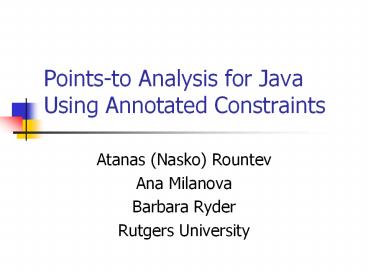Points-to Analysis for Java Using Annotated Constraints - PowerPoint PPT Presentation
Title:
Points-to Analysis for Java Using Annotated Constraints
Description:
Barbara Ryder. Rutgers University. Points-to Analysis for Java. Which objects may reference variable x point to? Builds a points-to graph. x = new A ... – PowerPoint PPT presentation
Number of Views:21
Avg rating:3.0/5.0
Title: Points-to Analysis for Java Using Annotated Constraints
1
Points-to Analysis for Java Using Annotated
Constraints
- Atanas (Nasko) Rountev
- Ana Milanova
- Barbara Ryder
- Rutgers University
2
Points-to Analysis for Java
- Which objects may reference variable x point to?
- Builds a points-to graph
x new A() y new B() x.f y
3
Uses of Points-to Information
- Clients compilers and SE tools
- Object read-write information
- Side-effect analysis, dependence analysis
- Call graph construction
- Devirtualization inlining
- Synchronization removal
- Stack-based object allocation
4
Our Work
- Define a points-to analysis for Java
- Based on Andersens analysis for C
- Efficient constraint-based implementation
- Annotated constraints
- Empirical evaluation of cost and precision
5
Outline
- Points-to analysis for Java
- Constraint-based implementation
- Empirical results
- Summary future work
6
Our Points-to Analysis
- Based on Andersens analysis for C
- Handles virtual calls
- Simulates the run-time method lookup
- Models the fields of objects
- Analyzes executable code
- Ignores dead code from reusable modules
7
Points-to Analysis in Action
class A void m(X p) .. class B extends A
X f void m(X q) this.fq B
b new B() X x new X() A a b a.m(x)
8
Efficient Implementation
- Because of Andersens analysis cubic worst-case
complexity - Constraint-based approach
- Extends previous work for C in BANE
- Define and solve a system of annotated
set-inclusion constraints
9
Annotated Constraints
- Form L ? a R
- L and R denote sets
- Annotation a additional information
- Kinds of set expressions L and R
- Set variables represent points-to sets
- ref terms represent objects
- Other kinds of expressions
10
Set variables and ref terms
- Set variables represent points-to sets
- For each reference variable p VP
- For each object o Vo
- Object o is denoted by term ref(o,Vo)
11
Example Accessing Fields
ref(o1,VO1) ? VP
p new A() q new B() p.f q
ref(o2,VO2) ? Vq
VP ? proj(ref,W) Vq ? f W
W ? VO1
Vq ? f VO1
ref(o2,VO2) ? f VO1
12
Example Virtual Calls
VP ? m lam(Vx)
p.m(x)
13
Experiments
- 23 Java programs 14 677 user classes
- Added the necessary library classes
- Machine 360 MHz, 512Mb
- Cost time and memory
- Precision
- Object read-write information
- Call graph construction
- Synchronization removal and stack allocation
14
Analysis Time
15
Number of new X() whose objects are accessed by
p.f
16
Resolution of Virtual Call Sites
17
Thread-local new sites
18
Summary
- Defined a points-to analysis for Java
- Implementation with annotated constraints
- Practical cost and good precision
- Future work
- Impact on client applications
- Efficient context-sensitive analysis































